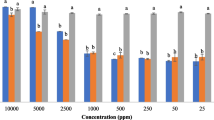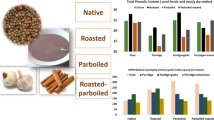Abstract
The objective of this work was to study chemical and nutritional aspects of different fractions of Prosopis alba. Flours from whole pod, pericarp (pulp) and seeds were obtained. Polyphenols were mainly located in pulp but antioxidant activity was higher in whole pod flour and seeds. In seeds, the fraction with the highest polyphenols and antioxidant activity was the seed coat or testa. Protein content was higher in whole pod flour (5.81 %) than in pulp flour (3.52 %), presenting the seed an appreciable amount 33.6 %. These proteins were composed by monomer subunits of 85, 67, 38, 16 and 14 kDa and no prolamins and anti-tryptic activity were detected. P. alba flours presented high content of soluble sugars, mainly composed by sucrose, and also high amount of insoluble dietary fiber. The major mineral was potassium. The whole pod, due to the contribution of seeds, contained high amount of calcium, magnesium, iron and zinc, all indispensable minerals for human nutrition. Therefore, P. alba flours, mainly containing the seeds, constitute nutritional ingredients for bakery and gluten free products.




Similar content being viewed by others
References
Burkart A, (1976) A monograph of the genus Prosopis (Leguminosae subfam. Mimosoideae). Part 1–2. J Arnold Arbor 57(3):219–249//450–425
E.M. Carrión, Uso de algarroba como sucedáneo del café, in Facultad de Ingeniería (Universidad De Piura, Lima, 1988), p. 56
Grados N, Cruz G (1996) New Approaches to Industrialization of Algarrobo (Prosopis pallida) Pods in Peru. In: P. Felker and J. Moss (eds) Prosopis: semiarid fuelwood and forage tree building consensus for the disenfranchised, Center for Semi-Arid Forest Resources, Texas
P. Felker et al., Economic assessment of production of flour from Prosopis alba and P. pallida pods for human food applications. J Arid Environ 53(4), 517–528 (2003)
D. Meyer et al., Processing, composition, nutritional evaluation, and utilization of mesquite (Prosopis spp.) pods as a raw material for the food industry. J Agric Food Chem 34(5), 914–919 (1986)
L. Bravo, N. Grados, F. Saura-Calixto, Composition and potential uses of mesquite pods (Prosopis pallida L): Comparison with carob pods (Ceratonia siliqua L). J Sci Food Agric 65(3), 303–306 (1994)
M. García-Andrade et al., Mesquite leaves (Prosopis laevigata), a natural resource with antioxidant capacity and cardioprotection potential. Ind Crops Prod 44, 336–342 (2013)
M.J. Pérez et al., Polyphenolic compounds and anthocyanin content of Prosopis nigra and Prosopis alba pods flour and their antioxidant and anti-inflammatory capacities. Food Res Int 64, 762–771 (2014)
A. Crozier, I.B. Jaganath, M.N. Clifford, Dietary phenolics: chemistry, bioavailability and effects on health. Nat Prod Rep 26(8), 1001–1043 (2009)
P. Kubatka, et al., Fruit peel polyphenols demonstrate substantial anti-tumour effects in the model of breast cancer. Eur J Nutr (2015). doi:10.1007/s00394-015-0910-5
F. Cattaneo et al., Anti-inflammatory and antioxidant activities, functional properties and mutagenicity studies of protein and protein hydrolysate obtained from Prosopis alba seed flour. Food Chem 161, 391–399 (2014)
M.L. Cardozo et al., Evaluation of antioxidant capacity, genotoxicity and polyphenol content of non conventional foods: Prosopis flour. Food Res Int 43(5), 1505–1510 (2010)
ASTM (2013) Standard specification for woven wire test sieve cloth and test sieves, ASTM International, West Conshohocken
AOAC (1998) Official methods of analysis of AOAC International, AOAC International, Gaithersburg
F.G. Chirdo, M.C. Añón, C.A. Fossati, Optimization of a competitive ELISA with polyclonal antibodies for quantification of prolamins in foods. Food Agric Immunol 7(4), 333–343 (1995)
Eliasson A-C (2006) Carbohydrates in food. 2nd ed. Food Science and Technology, CRC/Taylor & Francis, Boca Raton, p 546
M. Papagiannopoulos et al., Identification and quantification of polyphenols in carob fruits (Ceratonia siliqua L.) and derived products by HPLC-UV-ESI/MSn. J Agric Food Chem 52(12), 3784–3791 (2004)
M.J. Zaro et al., Distribution, stability and fate of phenolic compounds in white and purple eggplants (Solanum melongena L.). Postharvest Biol Technol 92, 70–78 (2014)
R. Re et al., Antioxidant activity applying an improved ABTS radical cation decolorization assay. Free Radic Biol Med 26(9–10), 1231–1237 (1999)
P.A. Sobral, J.R. Wagner, Relación entre la Composición y la Actividad Antitríptica de Sueros de Soja y Tofu y Comportamiento Térmico de sus Proteínas Aisladas. Información Tecnológica 20(5), 65–73 (2009)
R. Zolfaghari, H. Harden, L. Huffman, Some physical and chemical properties of honey mesquite pod (Prosopis glandulosa) and applications in food products. Cereal Chem 63(2), 104–108 (1986)
R. Becker, O.-K.K. Grosjean, A compositional study of pods of two varieties of mesquite (Prosopis glandulosa, P. velutina). J Agric Food Chem 28(1), 22–25 (1980)
N. Gharnit et al., Pomological characterization of carob tree (Ceratonia siliqua L.) from the province of Chefchaouen (NW of Morocco). Moroccan J Bio 2(3), 1–11 (2006)
A.L. Lamarque et al., Proximate composition and seed lipid components of some Prosopis (leguminosae) from argentina. J Sci Food Agric 66(3), 323–326 (1994)
B. Escobar et al., Uso de harina de cotiledón de algarrobo (Prosopis chilensis (Mol) Stuntz) como fuente de proteína y fibra dietética en la elaboración de galletas y hojuelas fritas. Archivos Latinoamericanos de Nutrición 59, 191–198 (2009)
P. Felker, R.S. Bandurski, Protein and amino acid composition of tree legume seeds. J Sci Food Agric 28(9), 791–797 (1977)
A. González Galán et al., Caracterización química de la harina del fruto de Prosopis spp. procedente de Bolivia y Brasil. Archivos Latinoamericanos de Nutrición 58, 309–315 (2008)
C. Bengoechea et al., Composition and structure of carob (Ceratonia siliqua L.) germ proteins. Food Chem 107(2), 675–683 (2008)
M.C. Puppo, C.E. Lupano, M.C. Añon, Gelation of soybean protein isolates in acidic conditions. Effect of pH and protein concentration. J Agric Food Chem 43(9), 2356–2361 (1995)
C.G.M. Da Silva et al., Caracterização físico-química e microbiológica da farinha de algaroba (Prosopis juliflora (Sw.) DC). Food Sci Technol (Campinas) 27, 733–736 (2007)
S. Choge et al., Prosopis pods as human food, with special reference to Kenya. Water SA 33(3), 419–424 (2007)
H.J.F. Zunft et al., Carob pulp preparation rich in insoluble fibre lowers total and LDL cholesterol in hypercholesterolemic patients. Eur J Nutr 42(5), 235–242 (2003)
S. Gruendel et al., Carob pulp preparation rich in insoluble dietary fiber and polyphenols enhances lipid oxidation and lowers postprandial acylated ghrelin in humans. J Nutr 136(6), 1533–1538 (2006)
USDA. Agricultural Research Service. 2013. USDA National Nutrient Database for Standard Reference, Release 26. Nutrient Data Laboratory Home Page. 2013 [cited 2013; Available from: http://www.ars.usda.gov/nutrientdata
Durán P et al. (2007) Encuesta Nacional de Nutrición y Salud Documento de Resultados, M.d. Salud, (ed), Buenos Aires, Argentina
M.R. Martinez Meyer et al., Content of zinc, iron and their absorption inhibitors in Nicaraguan common beans (Phaseolus vulgaris L.). Food Chem 136(1), 87–93 (2013)
J.T. Barminas, H.M. Maina, J. Ali, Nutrient content of Prosopis africana seeds. Plant Foods Hum Nutr 52(4), 325–328 (1998)
Acknowledgments
We want to acknowledge UNLP and CONICET of Argentina for the financial support.
Author information
Authors and Affiliations
Corresponding author
Rights and permissions
About this article
Cite this article
Sciammaro, L., Ferrero, C. & Puppo, M.C. Chemical and nutritional properties of different fractions of Prosopis alba pods and seeds. Food Measure 10, 103–112 (2016). https://doi.org/10.1007/s11694-015-9282-z
Received:
Accepted:
Published:
Issue Date:
DOI: https://doi.org/10.1007/s11694-015-9282-z




